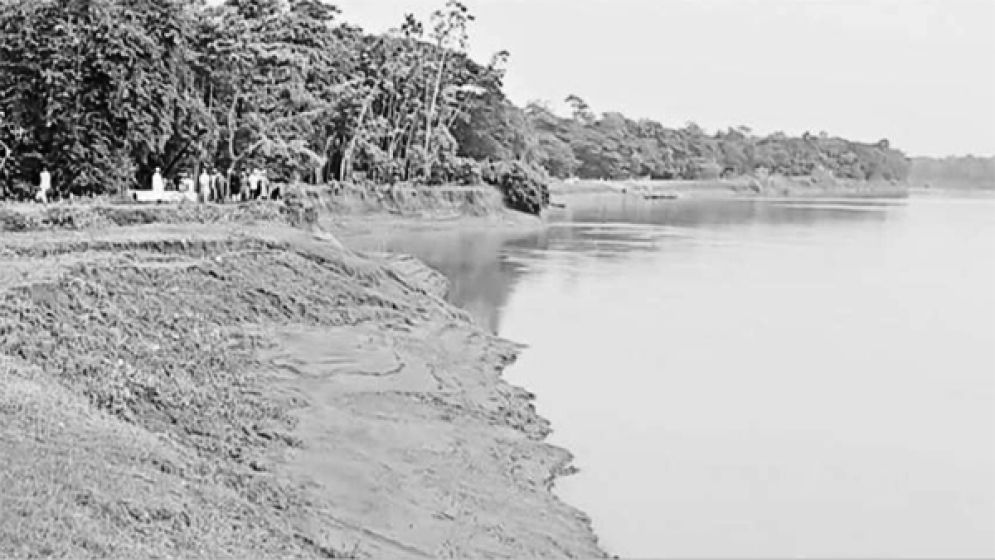'Wherever the Kushiyara flows, vast settlements have been lost'
UNB
Publish: 26 Oct 2024, 04:30 PM

Sylhet,
Oct 26 (UNB)--More than 50,000 people living along the banks of the Kushiyara
River in Sylhet's Beanibazar upazila are living in constant fear.
Severe erosion has
caused miles of roads to collapse into the river, and many structures-including
homes, schools, mosques, madrasas, and graveyards-have already gone into the
gorge of the river.
The embankment meant to
safeguard the riverbanks is also under threat.
Locals alleged that
despite the ongoing erosion, no effective measures have been implemented to
address the situation.
Beanibazar Upazila,
located in the northeast of Sylhet district, is bordered to the north by
Zakiganj, to the south by Baralekha, to the east by the Indian state of Assam,
and to the west by Golapganj. It is approximately 52 km from Sylhet Sadar.
This riverine region is
home to several rivers, including the Surma, Kushiyara, and Sonai. The
Kushiyara River, which originates from the Barak River in Assam, flows through
Zakiganj, Beanibazar, Golapganj, Fenchuganj, Balaganj, Rajnagar, Moulvibazar,
Nabiganj, and Jagannathpur.
"Wherever the
torrential Kushiara River flows, vast settlements have been lost," locals
lament. Despite various initiatives by the Water Development Board to protect
the riverbanks, erosion remains a significant issue.
In the Angura
Mohammadpur area, both banks of the Kushiyara River have suffered extensive
erosion over the past few years. "Roads, homes, schools, mosques,
madrasas, and graveyards have already been washed away."
"From Angura
Mohammadpur downstream to Amura in Golapganj Upazila, over three kilometers of
riverbank protection dams have crumbled, disrupting transportation."
Despite repeated
requests to the government for repairs, little progress has been made.
According to locals,
using blocks or geo bags could effectively protect the riverbanks.
Mizan Ahmad from Angura
Mohammadpur expressed concern: "The Kushiara River has swallowed parts of
our area. Three and a half kilometers of road from Angura Mohammadpur to Amura
Union have gone under the river, along with many houses." He added,
"Those who can afford left the place and built houses elsewhere"
Bahar Uddin, an
expatriate from the UK living in Angura Mohammadpur, noted that the river's
course has shifted dramatically over the last 25-30 years. "Where there
used to be settlements, there is now river, and where the river once flowed has
become land."
"As our roads have
gone into the river gorge, traveling has become very difficult," he said.
Kofil Uddin, head
teacher of Govindashri Government Primary School, mentioned that the collapse
of the riverbank dam severely disrupts student movement during the monsoon.
"Over 50,000 people in the area, including teachers and students, are
suffering a lot even in the dry season," he added.
Deepak Ranjan Das,
Executive Engineer of the Sylhet Water Development Board, recently visited the
erosion-affected Angura Mohammadpur area and assured residents that repair work
would begin soon.
He stated, "We are
working to address the breaking points as quickly as possible. A letter has already
been sent to higher authorities for funding, and erosion prevention efforts
will commence as soon as allocations are made."
Former member of the
Kurarbazar Union Parishad, Raju Alam, emphasized the need for effective
measures to combat river erosion.
"If the authorities
were to throw blocks or geo bags in the river, it could help save the
riverbank. Without permanent solutions to protect the Kushiara's banks, the
damage could escalate significantly," he noted.
END/UNB/Corr/SIS/ssk
